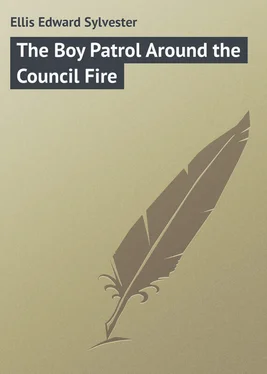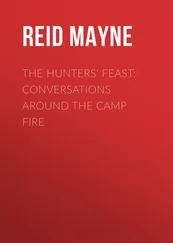Edward Ellis - The Boy Patrol Around the Council Fire
Здесь есть возможность читать онлайн «Edward Ellis - The Boy Patrol Around the Council Fire» — ознакомительный отрывок электронной книги совершенно бесплатно, а после прочтения отрывка купить полную версию. В некоторых случаях можно слушать аудио, скачать через торрент в формате fb2 и присутствует краткое содержание. ISBN: , Жанр: foreign_prose, foreign_children, на английском языке. Описание произведения, (предисловие) а так же отзывы посетителей доступны на портале библиотеки ЛибКат.
- Название:The Boy Patrol Around the Council Fire
- Автор:
- Жанр:
- Год:неизвестен
- ISBN:http://www.gutenberg.org/ebooks/43218
- Рейтинг книги:3 / 5. Голосов: 1
-
Избранное:Добавить в избранное
- Отзывы:
-
Ваша оценка:
- 60
- 1
- 2
- 3
- 4
- 5
The Boy Patrol Around the Council Fire: краткое содержание, описание и аннотация
Предлагаем к чтению аннотацию, описание, краткое содержание или предисловие (зависит от того, что написал сам автор книги «The Boy Patrol Around the Council Fire»). Если вы не нашли необходимую информацию о книге — напишите в комментариях, мы постараемся отыскать её.
The Boy Patrol Around the Council Fire — читать онлайн ознакомительный отрывок
Ниже представлен текст книги, разбитый по страницам. Система сохранения места последней прочитанной страницы, позволяет с удобством читать онлайн бесплатно книгу «The Boy Patrol Around the Council Fire», без необходимости каждый раз заново искать на чём Вы остановились. Поставьте закладку, и сможете в любой момент перейти на страницу, на которой закончили чтение.
Интервал:
Закладка:
“To make satisfactory progress in acquiring knowledge,” said he in his low, musical voice to which all listened with alert interest, “you must do so systematically. In our tramp through the woods the other day we picked up a good deal of information, but it was haphazard. We talked of trees as we came across them, but it was fragmentary and ten times as much was left unlearned as was learned. I am glad to know that your Scout Master has followed the right course in directing your study of our native trees, not alone in Maine but as far north as Canada, westward to the Rockies and down to the northern boundaries of the Southern States. The subject is too vast for us to cover in one evening or in a dozen evenings. Let us rather summarize. We shall put our wits together and see how many families we can name, without giving the different species under each. The first is the magnolia family, of which there are four varieties, while under the custard apple there is but one, the papaw. Now let me hear from you.”
Nearly an hour was spent during which scarcely a boy in the room kept silent. The pleased old man nodded his head and finally raised his hand for quiet.
“I believe you have mentioned about all. Now, while Isaac jots down the names at the table, let’s try to evolve something like order therefrom. Are you ready?”
Isaac Rothstein nodded and held his lead pencil over the paper. Here is the list upon which all finally agreed:
Magnolia, custard-apple, linden, rue, ailantus, holly, staff-tree, buckthorn, rose, pea, sumach, maple, horse chestnut, heath, honeysuckle, dogwood, ginseng, witch hazel, ebony, olive, begonia, laurel, mulberry, elm, plane-tree, walnut, birch, beech, willow, pine, yew and oak.
“None of you has seen all of these,” continued the old man, “but I hope you will have the opportunity of studying their peculiarities sometime. To illustrate what a rich treat is before you, we shall give a few minutes’ attention to the oak family, concerning which you may think I had considerable to say the other day. Let me show you how much was left unsaid.
“Most persons think of the oak as a slow grower. This is true of two or three species but not of the family. The majority need a hundred years to attain perfection and they rarely bear acorns until twenty years old. The acorn requires no protection in order to mature, and those that are not eaten by wild animals or trodden under foot do their work well. The quercus is one of the longest-lived trees.”
“What is the greatest age that they attain, Uncle Elk?” asked Scout Master Hall, one of the most interested in the audience.
“It is impossible to say, but there is little doubt that many of them flourish for a thousand years. There are vigorous oaks to-day in England that were old in the time of William the Conqueror. The famous White Oak of Hartford, in which Captain Wadsworth hid the charter two hundred and twenty-five years ago, was several centuries old at the time, and it was not until the summer of 1856 that a windstorm brought it to the ground. While it is one of the most valuable of the family, the white oak is in danger of extinction, because of its value as timber and on account of the sweetness of its nuts, which makes it a favorite with wild creatures that will not eat the bitter acorns of other oaks. You know the white oak is so called because of the color of its bark, which however is generally an ashen gray. Can any of you tell me the name of the oak that is fifty feet or slightly more in height, grows in Texas, has a fine-checked bark nearly the color of the white oak, with an awkward form and has shoots along the whole length of its branches, with the leaves coarse and rough on both sides? I shall not wait for you to guess the name, which is the post oak.
“The bur oak grows to a height of a hundred and fifty feet and ranges south to Texas and from the foothills of the Rockies to the Atlantic coast, being most abundant in Kansas and Nebraska. One of J. Fenimore Cooper’s most pleasing tales is ‘The Oak Openings,’ a name applied to the scattered forests of Minnesota. Now, you may know that the cork of commerce is the outer bark of an oak growing in southern Europe. The bur oak seems to be striving to produce the same thing and probably will succeed after awhile.
“The chestnut oak sometimes reaches a height of a hundred feet, but the trunk divides into large limbs a few feet above the ground. It is found in this State, westward through Ohio and as far south as Kentucky. It has many features in common with the yellow oak, whose range is somewhat different.
“The dwarf chinkapin, or scrub chestnut oak, is a shrub rarely more than a dozen feet high and grows on sandy or rocky soil. We do not meet with it north of Massachusetts. In Missouri and Kansas, it acquires dimensions more like a tree.
“The swamp white oak grows to a height of more than a hundred feet, and is fond of the borders of swamps. The top is narrow and round and the branches pendulous. You know about the red oak, which is a rapid grower and ranges from this State to Georgia and westward to Kansas, but attains its finest development north of the Ohio.
“To continue, I should add the names of the scarlet oak, the black and the yellow oak, the pin oak, the swamp Spanish, the bear, the scrub, the black jack, the barren, the shingle, the laurel, and the willow.
“You have noticed that I have done little more than mention the names of the different species. You have learned very little, for it is necessary that you should know the range of each, the height to which it grows, the characteristics of the bark, the wood, the leaves, the flowers and acorns. In conclusion, I shall say that the willow oak is one of the most interesting of trees. Its leaves resemble those of the willow, as do the straight slender shoots. It grows on the wet borders of swamps, but keeps away from the sea coast. Its acorns are very small, with a kernel so bitter that you would never bite into it a second time.
“My object this evening,” said Uncle Elk, “has been rather to awaken a desire on your part to study systematically our common American trees than to give you actual information. Let us dismiss the subject, for in dropping a matter of that kind we should follow the rule in eating, which is to stop before the appetite is cloyed. Suppose to-morrow night we have a little talk about American birds.”
There was general nodding of heads and the old man rose to his feet. He was so pleased with his listeners that he said:
“If we get through that subject in time, I’ll promise to tell you a story, provided you would like to hear one from me.”
He could be seen smiling behind his abundant gray beard.
“Boys will be boys always. Nothing suits them better than a story. So I shall bid you good night for the present, hoping nothing will interfere with our meeting again to-morrow evening.”
“The better plan,” suggested Scout Master Hall, “is for you to take supper with us, for I foresee that there will be much for you to tell us. We don’t want to miss the talk about birds, and I am as eager as the boys to hear your story, which I know will be a good one.”
All crowded around the Instructor in Woodcraft, shaking hands, thanking him and urging him so warmly to accept the invitation that he could not refuse. The last one with whom he clasped hands was Jack Crandall, who straightened up in his easy chair and declared he was receiving more benefit than a dozen doctors could impart.
Mike Murphy had risen to his feet at the close of the old man’s talk, but kept his place by the door until Uncle Elk came opposite. A nod of the hermit’s head told Mike that he wished to speak with him alone. The signal was observed by several who stayed behind as the two passed out and down the porch to the beach. Uncle Elk did not speak until they were beyond the hearing of the others. Then he halted and looked into the face of the youth.
Читать дальшеИнтервал:
Закладка:
Похожие книги на «The Boy Patrol Around the Council Fire»
Представляем Вашему вниманию похожие книги на «The Boy Patrol Around the Council Fire» списком для выбора. Мы отобрали схожую по названию и смыслу литературу в надежде предоставить читателям больше вариантов отыскать новые, интересные, ещё непрочитанные произведения.
Обсуждение, отзывы о книге «The Boy Patrol Around the Council Fire» и просто собственные мнения читателей. Оставьте ваши комментарии, напишите, что Вы думаете о произведении, его смысле или главных героях. Укажите что конкретно понравилось, а что нет, и почему Вы так считаете.












